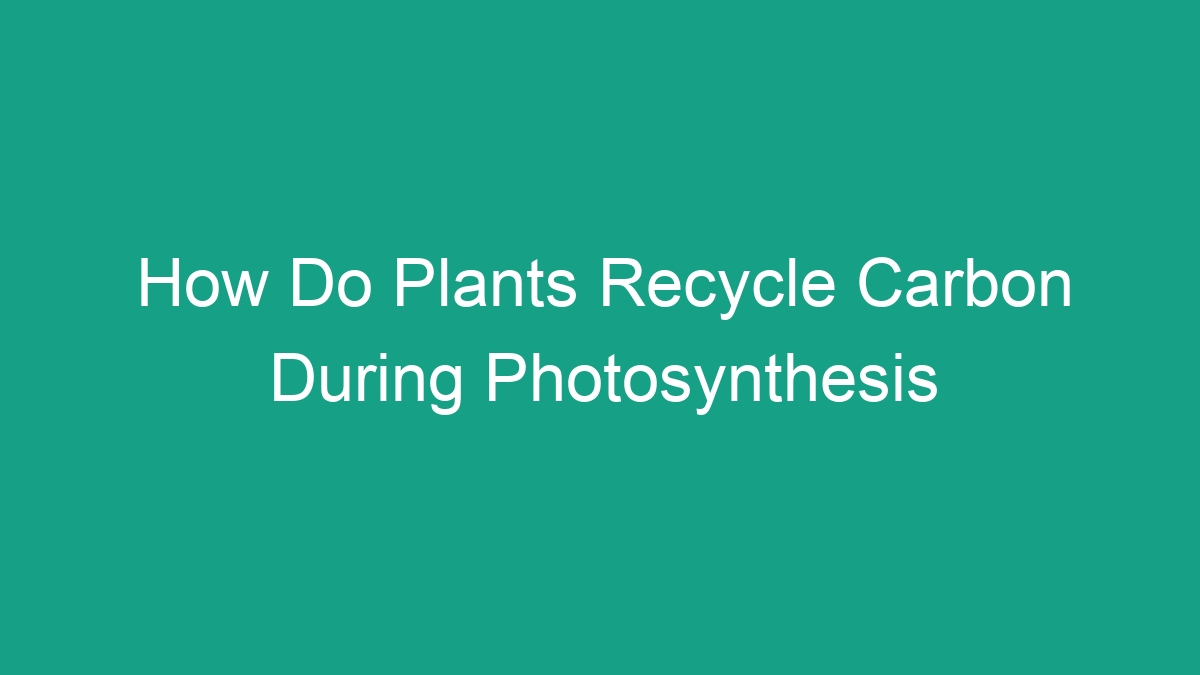
Plants play a crucial role in the Earth’s carbon cycle by recycling carbon dioxide during photosynthesis. In this article, we will explore the process of how plants recycle carbon through photosynthesis and the importance of this process in sustaining life on our planet.
The Role of Photosynthesis in Carbon Recycling
Photosynthesis is the process by which green plants, algae, and some bacteria use sunlight to synthesize food from carbon dioxide and water. During this process, plants absorb carbon dioxide from the atmosphere and convert it into organic compounds, such as glucose, which serve as a source of energy for the plant.
By capturing carbon dioxide from the atmosphere, plants play a significant role in offsetting the accumulation of greenhouse gases, which contribute to global warming and climate change. Through photosynthesis, plants effectively recycle carbon from the atmosphere, mitigating the impact of carbon emissions on the environment.
The Steps of Photosynthesis
The process of photosynthesis consists of several key steps, which are essential for the recycling of carbon dioxide.
- Carbon Dioxide Absorption: Plants take in carbon dioxide from the atmosphere through small openings in their leaves called stomata.
- Light Absorption: Chlorophyll, the green pigment in plant cells, absorbs sunlight, providing the energy necessary for the photosynthesis process.
- Conversion of Carbon Dioxide: Inside the leaf’s chloroplasts, carbon dioxide is converted into glucose through a series of chemical reactions involving water and sunlight.
- Oxygen Release: As a byproduct of the photosynthesis process, plants release oxygen back into the atmosphere, supporting the respiratory needs of living organisms.
The Importance of Carbon Recycling in Plants
The ability of plants to recycle carbon through photosynthesis is critically important for several reasons:
- Climate Regulation: By removing carbon dioxide from the atmosphere, plants help regulate the Earth’s climate and reduce the impact of global warming.
- Oxygen Production: Photosynthesis is the primary source of oxygen production on Earth, sustaining the respiration of animals and humans.
- Food Production: The organic compounds produced through photosynthesis serve as the foundation for the entire food chain, supporting the growth and development of all living organisms.
- Carbon Sequestration: Plants store carbon in their tissues, serving as a natural carbon sink and helping to mitigate carbon emissions in the environment.
Factors Affecting Carbon Recycling in Plants
While photosynthesis is a fundamental process for carbon recycling in plants, several factors can influence the efficiency of this process:
- Light Availability: Plants require sufficient sunlight to drive the photosynthesis process and recycle carbon dioxide effectively.
- Carbon Dioxide Levels: Higher concentrations of carbon dioxide in the atmosphere can enhance the rate of photosynthesis in plants, leading to increased carbon recycling.
- Temperature: The optimal temperature range for photosynthesis varies among plant species, impacting their ability to recycle carbon effectively.
- Water Availability: Adequate water supply is essential for plants to maintain turgor pressure and facilitate the transport of nutrients during photosynthesis.
The Impact of Deforestation on Carbon Recycling
Deforestation has a profound impact on the Earth’s carbon cycle, disrupting the natural process of carbon recycling by plants:
- Carbon Emissions: Deforestation releases large amounts of stored carbon into the atmosphere, contributing to increased greenhouse gas levels and climate change.
- Reduced Carbon Sink: With fewer trees to absorb and store carbon, the capacity for natural carbon sequestration is diminished, exacerbating the effects of carbon emissions.
- Loss of Biodiversity: Deforestation results in the loss of plant species that play a critical role in carbon recycling, further compromising the resilience of ecosystems.
Enhancing Carbon Recycling in Plants
Efforts to enhance carbon recycling in plants can significantly contribute to mitigating climate change and preserving the environment:
- Reforestation: Planting trees and restoring natural forest ecosystems can expand the capacity for carbon sequestration and promote sustainable carbon recycling.
- Carbon-Capture Technologies: Research and development of technologies that capture and store carbon emissions can complement the natural process of carbon recycling in plants.
- Climate-Smart Agriculture: Implementing agricultural practices that prioritize carbon sequestration and efficient carbon recycling in crops can have a positive impact on the environment.
Conclusion
Plants play a vital role in the recycling of carbon through the process of photosynthesis, effectively capturing carbon dioxide from the atmosphere and converting it into organic compounds. The significance of carbon recycling in plants extends beyond environmental sustainability, influencing climate regulation, oxygen production, and food security. Understanding the mechanisms of carbon recycling in plants is essential for addressing global challenges related to climate change and promoting a healthy and balanced ecosystem.
FAQs (Frequently Asked Questions)
Q: How do plants recycle carbon during photosynthesis?
A: Plants recycle carbon dioxide during photosynthesis by absorbing it from the atmosphere through their leaves’ stomata and converting it into organic compounds, such as glucose, using energy from sunlight.
Q: What is the role of carbon recycling in plants?
A: Carbon recycling in plants helps regulate the Earth’s climate by removing carbon dioxide from the atmosphere, supports oxygen production, serves as the foundation for the food chain, and contributes to carbon sequestration.
Q: How does deforestation impact carbon recycling in plants?
A: Deforestation disrupts the natural process of carbon recycling in plants, leading to increased carbon emissions, reduced carbon sequestration, and loss of biodiversity, which all contribute to environmental degradation.



